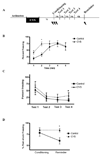Enhanced fear recall and emotional arousal in rats recovering from chronic variable stress
- PMID: 20678511
- PMCID: PMC2952501
- DOI: 10.1016/j.physbeh.2010.07.013
Enhanced fear recall and emotional arousal in rats recovering from chronic variable stress
Abstract
Emergence of posttraumatic-like behaviors following chronic trauma is of interest given the rising prevalence of combat-related posttraumatic stress disorder (PTSD). Stress associated with combat usually involves chronic traumatization, composed of multiple, single episode events occurring in an unpredictable fashion. In this study, we investigated whether rats recovering from repeated trauma in the form of chronic variable stress (CVS) express posttraumatic stress-like behaviors and dysregulated neuroendocrine responses. Cohorts of Long-Evans rats underwent a 7 day CVS paradigm followed by behavioral and neuroendocrine testing during early (16 h post CVS) and delayed (7 day) recovery time points. A fear conditioning-extinction-reminder shock paradigm revealed that CVS induces exaggerated fear recall to reminder shock, suggestive of potentiated fear memory. Rats with CVS experience also expressed a delayed expression of fearful arousal under aversive context, however, social anxiety was not affected during post-CVS recovery. Persistent sensitization of the hypothalamic-pituitary-adrenocorticotropic response to a novel acute stressor was observed in CVS exposed rats. Collectively, our data are consistent with the constellation of symptoms associated with posttraumatic stress syndrome, such as re-experiencing, and arousal to fearful contexts. The CVS-recovery paradigm may be useful to simulate trauma outcomes following chronic traumatization that is often associated with repeated combat stress.
Copyright © 2010 Elsevier Inc. All rights reserved.
Figures





References
-
- Buydens-Branchey L, Noumair D, Branchey M. Duration and intensity of combat exposure and posttraumatic stress disorder in Vietnam Veterans. J Nerv Ment Dis. 1990;178:582–587. - PubMed
-
- Stam R. PTSD and stress sensitization: A tale of brain and body Part 2:Animal models. Neuroscience and Biobehavioral Rev. 2007;31:558–584. - PubMed
-
- Servatius RJ, Ottenweller JE, Natelson BH. Delayed startle sensitization distinguishes rats exposed to one or three stress sessions: further evidence toward an animal model of PTSD. Biol Psy. 1995;38:539–546. - PubMed
-
- Wakizono T, Sawamura T, Shimizu K, Nibuya M, Suzuki G, Toda H, Hirano J, Kikuchi A, Takahashi Y, Nomura S. Stress vulnerabilities in an animal model of post-traumatic stress disorder. Physiol and Behavior. 2007;90:687–695. - PubMed
Publication types
MeSH terms
Substances
Grants and funding
LinkOut - more resources
Full Text Sources
Medical

